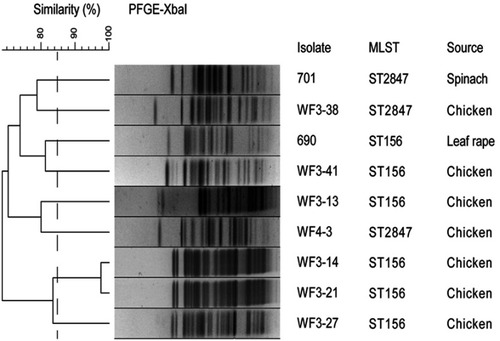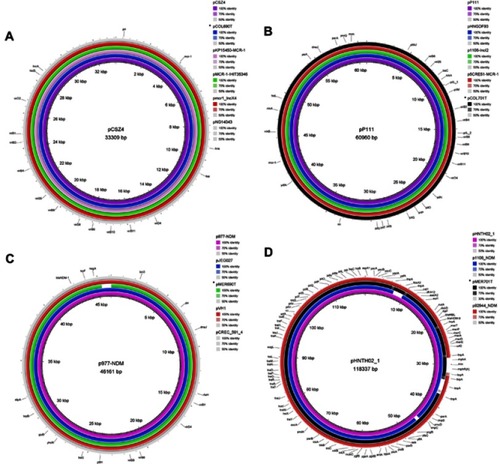Figures & data
Table 1 Characteristics of the two E. coli strains 690 and 701 from fresh vegetables and their transconjugants with plasmids either harboring mcr-1 or blaNDM-5/-9
Figure 1 XbaI-PFGE patterns of isolates in this study and isolates of ST156 and ST2847 types co-carrying mcr-1 and blaNDM from avian.

Figure 2 Analysis of the location of mcr-1/blaNDM among transconjugants and their donors. (A) S1 nuclease-PFGE of transconjugants and their donors carrying blaNDM. (B) Southern blot hybridization with the blaNDM probe. (C) S1 nuclease-PFGE of transconjugants and their donors carrying mcr-1. (D) Southern blot hybridization with the mcr-1 probe. Lane M: chromosomal DNA of Salmonella enterica serotype Braenderup H9812 digested with XbaI serving as size markers. The red arrows indicate bigger bands, which are portion of the mcr-1/blaNDM-5/9-carrying plasmids not exposed to S1 nuclease in the S1-PFGE experiment.

Figure 3 Sequence alignment of blaNDM-bearing or mcr-1-bearing plasmids. (A) The plasmid pCSZ4 (KX711706) (purple ring) from E. coli of pork origin in China was used as a reference to compare with the IncX4 plasmids. The ring light purple, green, red, gray and blue rings represent pKP15450-MCR-1 (MH715959) from clinical K. pneumoniae in Taiwan, pMCR-1-IHIT35346 (KX894453) from E. coli of pig origin in Germany, pmcr1_IncX4 (KU761327) from clinical K. pneumoniae in China, pNG14043 (KY120364) from clinical S. typhimurium in Taiwan and pCOL60T (VMKQ00000000) in this study, respectively. The outer circle with black arrows signifies annotation of the reference sequence. (B) The plasmid pP111 (KY120365) from S. typhimurium of pig in Taiwan was used as a reference to compare with the IncI2 plasmids. The purple, blue, green, red and black rings represents the reference plasmid, pHNGDF93 (MF978388) from fish E. coli in China, p1106-IncI2 (MG825374) from E. coli of chicken in China, p5CRE51-MCR-1 (CP021176) from clinical E. coli in Taiwan, and pCOL701T (VMKR00000000) in this study, respectively. The outer circle with black arrows signifies annotation of the reference sequence. (C) The plasmid p977-NDM (MG825382) from E. coli of pork origin in China was used as a reference to compare with the IncX3 plasmids. The purple, blue, green, red and gray rings represent the reference plasmid, pJEG027 (KM400601) from clinical K. pneumoniae in Australia, pMER690T (VMKS00000000) from leaf rape in this study, pVH1 (CP028705) from E. coli of cucumber in China, and pCREC-591_4 (CP024825) from clinical E. coli in South Korea, respectively. The outer circle with black arrows signifies annotation of the reference sequence. (D) The plasmid pHNTH02-1 (MG196294) from E. coli of retail meat in China was used as a reference (purple ring). The blue, dark, and red rings represent plasmid p1106-NDM (MG825375) from E. coli of chicken, pMER701T (VMKT0000000) in this study, and p92944-NDM (MG838206) from clinical E. coli, respectively, in China. The outer circle with black arrows signifies annotation of the reference sequence. *represents plasmids in this study.

